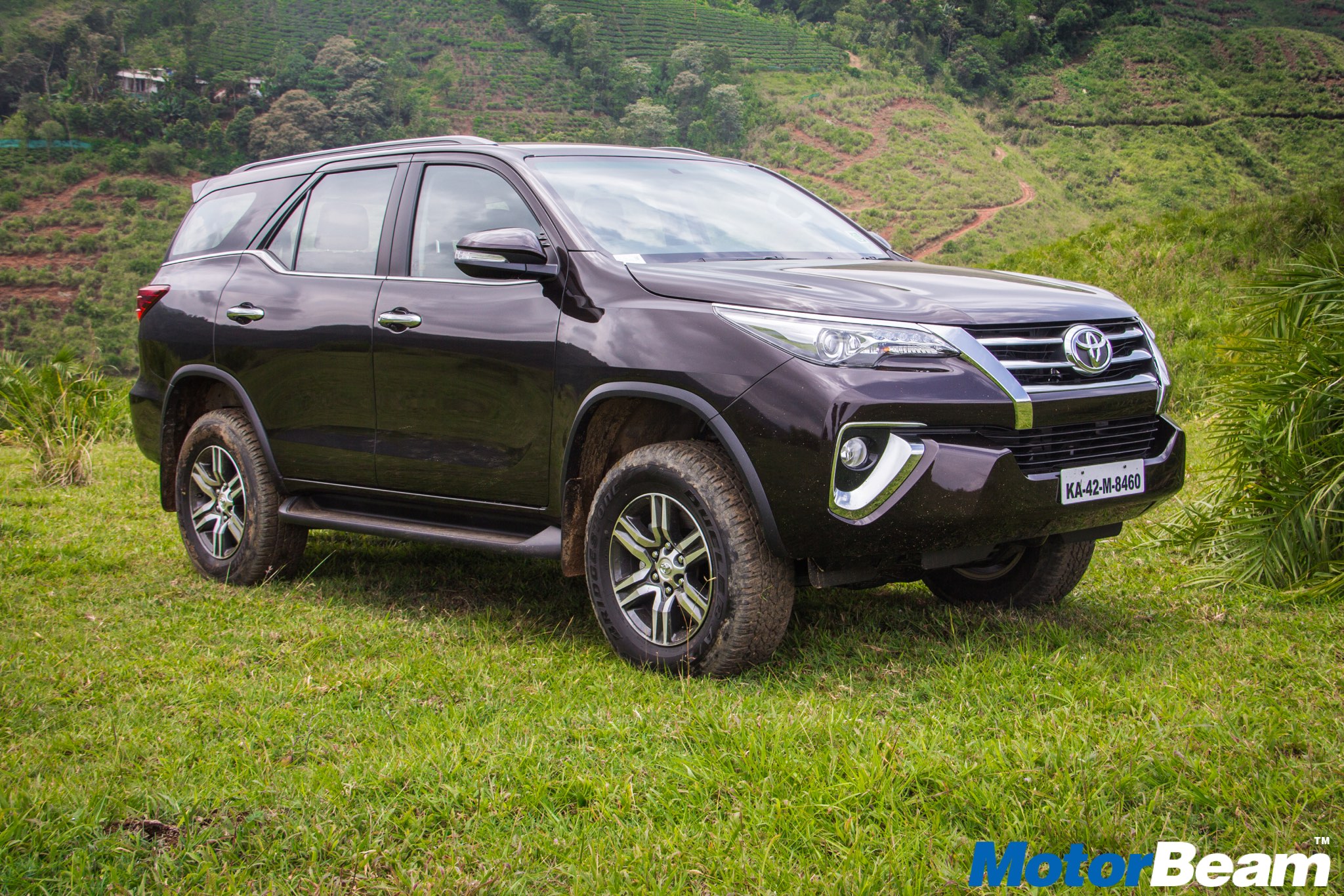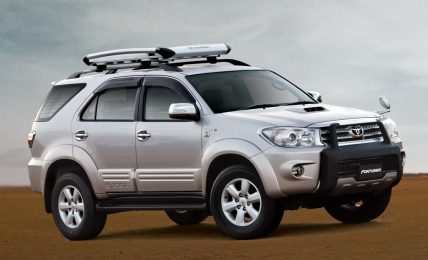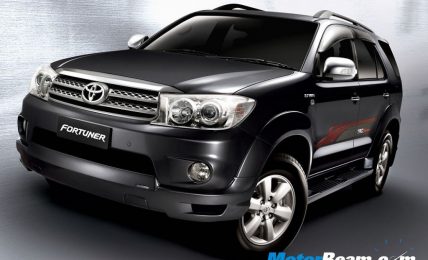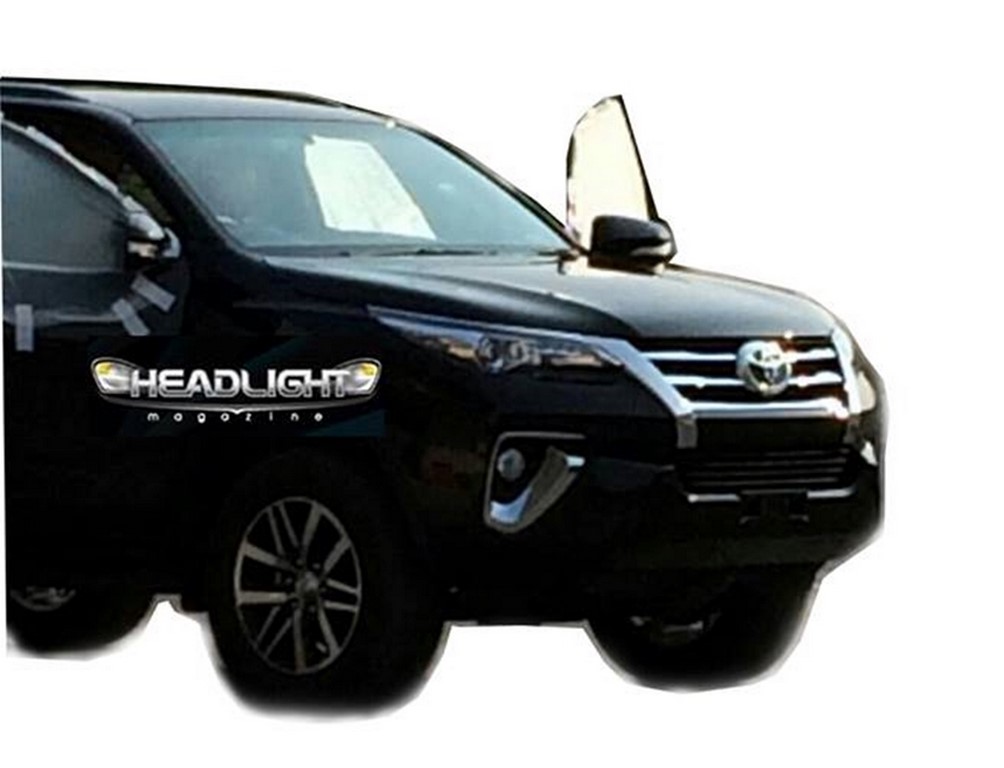
2017 Toyota Fortuner Review
Car Tested: 2017 Toyota Fortuner; Road Test No. 760; Test Location: Kerala
Price OTR Mumbai: Rs. 31.50 – 37.25 lakhs
The 2017 Toyota Fortuner has evolved in leaps and bounds over the outgoing generation car
Last decade, the full-size SUV segment was very popular, there were a multitude of options in the segment and every manufacturer who had presence in this space was enjoying decent sales. And then Toyota decided to launch the Fortuner, overnight sales of all other SUVs came tumbling down as Toyota sold more Fortuners than all other options in the segment combined. That’s how popular the Fortuner has been, averaging around 1000 unit sales a month which is a big feat considering the price of the vehicle. After 7 years of being on sale, Toyota has now launched the second generation Fortuner in India and it seems to have won half its battle with the design itself, or has it?
Motor Quest: Toyota launched the Fortuner in India in 2009 after generating a lot of anticipation and it was an instant hit. Waiting period for the car was long in its initial months and people were even ready to pay a slight premium to get quick delivery of their vehicles.
The styling of the new Toyota Fortuner is very sleek
Exteriors – Toyota’s latest design direction is changing towards a more sleeker and athletic appearance to cut the visual bulk as seen on the Innova Crysta. Same is the case with the new Fortuner. It comes with sleek new wraparound headlights, huge chrome grille and a heavily sculpted bumper with integrated foglamps. The side profile reveals its clean and tall design. There are new shiny set of alloy wheels that add some premium touch and beyond the C-pillar, it looks quite sharp with the slight kink, extended tail light and a floating roof appearance.
The SUV continues to have a very imposing stance
Toyota has put much more effort on the design of the Fortuner which is evident
The LED wraparound tail lights look very neat, there is a protruding roof spoiler as well and a dash of chrome that doesn’t look overdone. The new generation Toyota Fortuner is longer and wider than the previous model but the wheelbase is exactly the same while the height is also a tad shorter. All in all, the new styling looks very appealing and the presence on the road of the new Fortuner is grand.
The new interiors are generations ahead compared to the old model
Interiors – Get inside the cabin and the design flow of the new Fortuner’s dashboard will remind you of the Innova Crysta to some extent. The cabin feels rich and premium than before in terms of quality and finish and also the attention to detail. The new steering wheel feels good to hold having a matte silver lower half. The instrument cluster is big and easy to read which also has a sizeable MID display that shows all the necessary info about the car and also information from the media system. The top half of the dashboard gets AC vents and the centre console is uniquely highlighted with silver accents along with a dash of leatherette upholstery with double stitching that gives you a premium car feel.
There are way too many features on offer but still not enough!
The infotainment system consists of a big 7.0-inch touch-screen display with USB, AUX, DVD, MP3 and Bluetooth connectivity for music streaming and telephony. It comes with a 6-speaker audio system that offers decent aural experience. Sadly there is no Apple CarPlay and Android Auto connectivity, which is the trending car tech on offer these days. The new Fortuner comes with Navigation, which is user friendly and the screen also doubles up as a display for the reverse camera with parking guidelines (not adaptive). Unlike the new Ford Endeavour, the Toyota Fortuner doesn’t come with the fancy auto park assist.
The seats are large and comfortable for short and tall passengers
The 2017 Toyota Fortuner is offered with an 8-way electrically adjustable driver’s seat that offers good visibility and is suitable for both tall and short passengers. It also comes with power foldable and adjustable ORVMs, keyless entry (the smart key looks very fancy) and go with push button start/stop, cruise control, auto headlamps, powered tail gate and a ton of new features which you haven’t seen on the previous generation model. However, it misses out on dual-zone climate control system, sunroof and electrically folding third row seats, all of these are available in the American SUV.
The Fortuner isn’t very practical, at least far less than the Innova
The Fortuner’s cabin is very good on quality and feel with loads of features
The new gen Toyota Fortuner gets a dark brown upholstery, which looks almost black in dark conditions. It makes the cabin feel rich and the seats offer tremendous support for the back and under-thighs. The second row has ample space with good legroom, kneeroom and shoulder room but under-thigh support is lacking and seating three people abreast isn’t a good idea. The third row is a tight fit for adult passengers specially compared to the more spacious Innova Crysta’s third row seating, as one sits low down with the knees close to the chest and poor under-thigh support.
The cluster is easy to read, offers ton of information
There are low storage spaces in the cabin (considering how many more bottle holders are there in the Innova Crysta) in spite of it having dual glove box including one cooled compartment, two bottle holders on the dashboard for the front passengers near the AC vents (can be converted into a cubby hole), cupholders near the centre console, all four door pockets (the last row also gets them) with bottle holders (the rear ones can’t be easily accessed due to the position of the bottle holders being too far back, one really has to open the door to easily get to the bottle), front arm rest storage, hooks for hanging bags and power sockets for all three rows. Boot space is pretty decent, the third row has 50:50 split that fold up and the second row have 60:40 split so you can easily fit luggage and accommodate four passengers (the last row doesn’t have much space and a third passenger in the second row is a tight squeeze, the seat too is hard and putting the roof mounted seatbelt on takes quite a lot of time) comfortably in the new Fortuner.
The Fortuner gets powerful engines with with 3 drive modes
Performance – Toyota is offering the Fortuner with both diesel and petrol engine options, the latter catering to a meagre set of buyers as less than 5% sales will come from the gasoline model. We drove the petrol model first which is offered with both 5-speed manual and 6-speed automatic gearbox options. Our test car was the automatic. The petrol powered Toyota Fortuner is only offered in 2WD guise but it still weighs close to 300 kgs more than the Innova Crysta with which it shares the 2.7-litre petrol engine, generating identical power and torque numbers.
The petrol engine has adequate performance but isn’t punchy
The diesel is easily the pick over the petrol Fortuner with better performance
The petrol motor is very refined, it’s almost silent at idle but once you get going, it gets quite vocal, more so near the 6000 RPM redline. There is good punch lower down and the powerband is wide but it still doesn’t have the same zest as its MPV sibling which feels quicker. Revs don’t climb up quickly which is surprising as Japanese engines are known to be free revving. Meanwhile the diesel, which is the 2.8-litre unit, is also shared with the Innova but gets a 3 PS increase in power and 90 Nm increase in torque (60 Nm increase when you compare the Innova 2.8 AT with the Fortuner 2.8 MT, the Crysta 2.8 isn’t offered with a manual gearbox).
The diesel Toyota Fortuner is quick and has ample grunt
The added punch is immediately apparent and does well to negate the weight disadvantage of the Fortuner. The diesel motor is punchy and has a good low-end and a strong mid-range, it redlines at 4500 RPM and similar to the petrol motor, has good NHV lower down but gets very vocal once you get past the mid-range. The automatics are slightly lower on NVH while the manual is even louder, the 6-speed manual gearbox in the diesel Fortuner offers smooth shifts (other than reverse which requires some effort) while the clutch is surprisingly very light for such a high displacement powerplant. Driving in top gear in the manual and doing the ton, results in just 1500 RPM on the tacho, 100 km/hr coming up in third gear which is very versatile as one can potter around town in the same gear, that’s how drivable the oil burner is.
The 6-speed automatic gearbox is quite slow to shift cogs
The diesel engine (both manual and automatic gearbox options) are also available with 4-wheel drive and Toyota has got rid of the additional gear lever for a rotary knob to switch modes. Our test cars were returning around 6 km/l and 10 km/l for the petrol and diesel engines respectively. Both the engines get three drive modes – Eco, Normal (default model) and power, a difference can be felt in each of them as with Eco, performance dulls a bit in the interest of efficiency while in power, you can feel the added punch. The manual gets an iMT button (next to the Eco button near the handbrake) which basically prevents revs from dropping for added performance, enabling this will affect the fuel efficiency slightly. The automatic gearbox isn’t fast with shifts and Toyota has given it paddle shifters so when you use them, you realise how long the shifts take, for example, when we were upshifting 500 RPM before the redline, the motor would still hit the rev limit, so the AT is smooth but not fast by any means.
The steering is heavy at low speeds but should have weighed up better
Driving Dynamics – The 2017 Toyota Fortuner gets an updated chassis which is stiffer and tougher than its predecessor. You instantly notice how composed the new vehicle is, as it remains very stable at high speeds. Handling too has improved although there is still considerable body roll around corners. The steering is heavy at low speeds which makes it cumbersome to drive in the city and out on the highway, it does weigh up decently. The ride quality has improved drastically over the first generation car but is still stiff over bad roads, more so at the rear. The Fortuner isn’t a very comfortable SUV as far as driving on Indian roads go.
Ride quality is stiff and the Fortuner gets uncomfortable over bad roads
The ride isn’t good but it has improved, so has the handling, braking and stability
The Toyota Fortuner also sees drastic improvement to its braking, it stops faster than before and the pedal bite is reassuring. The company has equipped all wheels with discs. Our drive over the off-road section in an estate in Kerala showed the capability of the Fortuner which dealt with everything with ease. The new model doesn’t get full time four-wheel drive but the Sigma 4 system gets a switch to toggle between 2WD, 4WD and 4WD Low modes. It gets a virtual LSD which does braking on each wheel individually. There is ample ground clearance and the rugged ladder frame means it can do quite a lot of off-roading without getting stuck.
The Fortuner is loaded to the gills with safety equipment
Safety and After Sales Service – This time around the new Toyota Fortuner offers an array of safety features making it a much safer SUV to be in. Toyota is offering 7 airbags, ABS, EBD, Brake Assist, Traction Control System, Vehicle Stability Control, Trailer Sway Control, Hill Hold Assist, Hill Descent Control and a few more tech. As far as after sales is concerned, the Toyota badge has always been known for its reliability and durability. The Japanese automaker has good reach in India but the cost of ownership of the new Fortuner might be a bit higher compared to its smaller siblings.
The Fortuner will sell well but won’t give sleepless nights to rivals
Verdict – Last time around, when Toyota launched the Fortuner in India, it just walked over its rivals and became the segment king. This time too, it will sell in good numbers but in spite of being a vastly improved product, it simply won’t dominate the segment like before. That’s because, the new Ford Endeavour is on equal footing, the Fortuner’s own sibling, the Innova Crysta is more practical and comfortable and costs less too, so for those looking for a Toyota UV, the MPV makes more sense. Of course, if you want a Japanese SUV, the Fortuner is the one to pick.
The Fortuner gets tough competition from the Endeavour
What’s Cool
* One of the best looking ladder frame SUVs
* Interior is feature loaded and luxurious
* Improved dynamics over the old model
* Diesel engine has excellent performance, is very fun to drive
* Gets a lot of safety tech, both active and passive
* Toyota’s quality, reliability and resale value
What’s Not So Cool
* Both petrol and diesel engines get vocal once past the mid-range
* Automatic gearbox is slow with shifts
* Stiff ride quality makes this an uncomfortable SUV
* Second row bottle holders are positioned too far back
* Long equipment list but misses out features offered by its arch nemesis
Alternatives: Ford Endeavour, Mitsubishi Pajero Sport
The new Toyota Fortuner too is likely to have a huge fanbase
2017 Toyota Fortuner Specifications
* Engine: 2694cc, DOHC, Dual VVT-i, 16V, 4-cylinder | 2755cc, 1GD-FTV, 16V, 4-cylinder, Turbocharged, DOHC
* Power: 166 PS @ 5200 RPM | 177 PS @ 3400 RPM
* Torque: 245 Nm @ 4000 RPM | 420 Nm (MT) / 450 Nm (AT) @ 1600-2400 RPM
* Transmission: 5-speed manual, 6-speed AT | 6-speed MT, 6-speed automatic
* 0-100 km/hr: 13 seconds (Petrol), 12 seconds (Diesel) (est.)
* Fuel Consumption: 6 km/l | 10 km/l
* Fuel Type: Petrol | Diesel
* Suspension: Independent double wishbone (Front), Four-Link (Rear)
* Tyres: 265/60/18 (4WD), 265/65/17 (2WD)
* Brakes: Ventilated Discs (Front), Disc (Rear), ABS
* Safety: 7 Airbags, ABS, EBD, Vehicle Stability Control and Hill-Start Assist Control, DAC, Traction Control
2017 Toyota Fortuner Dimensions
* Overall length x width x height: 4795 mm X 1855 mm X 1835 mm
* Wheelbase: 2745 mm
* Ground clearance: 225 mm
* Turning radius: 5.8-metres
* Fuel Tank Capacity: 80-litres
* Gross Weight: 2500-2735 kgs
Further Reading –
2017 Toyota Fortuner Video Review




